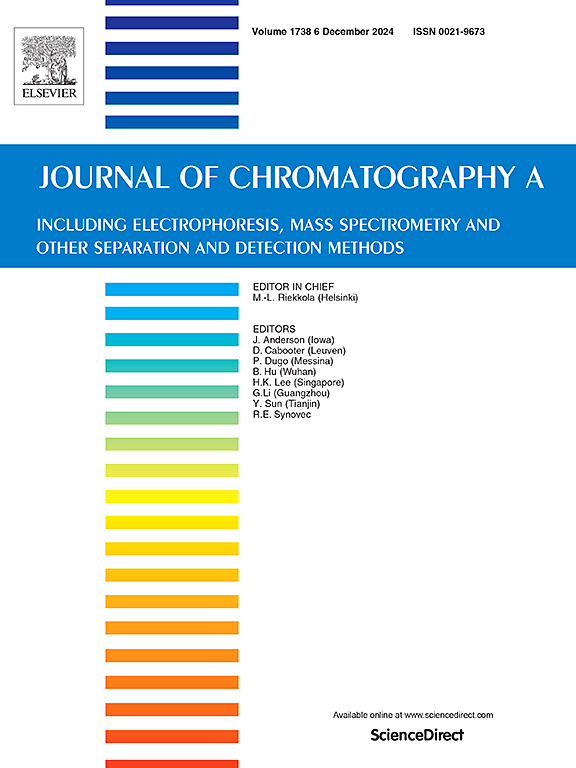A methylation-assisted gas chromatography-mass spectrometry strategy for comprehensive monosaccharide profiling in Polygonatum polysaccharides: Overcoming limitations of conventional chromatographic techniques
IF 4
2区 化学
Q1 BIOCHEMICAL RESEARCH METHODS
引用次数: 0
Abstract
Conventional methods for analyzing monosaccharides, such as 1-Phenyl-3-methyl-5-pyrazolone (PMP) derivatization coupled with high-performance liquid chromatography (HPLC), struggle to detect ketoses and acidic sugars. This limitation hinders the precise structural analysis of polysaccharides in traditional Chinese medicine (TCM). A methylation-assisted Gas Chromatography-Mass Spectrometry (GC–MS) approach was developed to address this issue in the current study. By optimizing the methylation process and using GC–MS with a BR-17 column and an Electron Ionization (EI) source, simultaneous detection of ten different monosaccharides was achieved within 20 min. GC–MS profiling of monosaccharides generally gives two peaks per analyte, except in the cases of fructose and galacturonic acid. Notably, fructose (Fru) was identified for the first time in the polysaccharides of Polygonatum species: P. sibiricum at 18.55 μg/mg, P. cyrtonema at 16.90 μg/mg, and P. kingianum at 14.35 μg/mg, overcoming the limitations of the inability to detect ketoses in the PMP-HPLC method. Data analysis revealed distinct species-specific markers: P. kingianum polysaccharides (PKP) uniquely contained α-galacturonic acid (α-Gal: 19.95 μg/mg), whereas P. sibiricum polysaccharides (PSP) featured six monosaccharides, including glucose (Glc: 135.45 μg/mg), mannose (Man: 78.95 μg/mg), and ribose (Rib: 26.90 μg/mg), with a total of 299.50 μg/mg. P. cyrtonema polysaccharides (PCP) showed elevated levels of glucuronic acid (GlcA, 38.40 μg/mg). This derivatization-enhanced GC–MS method effectively fingerprints TCM polysaccharides, enabling clear differentiation of Polygonatum species through analysis of monosaccharide composition and total sugar content. This approach establishes clear structural distinctions, overcoming the limitations of conventional chromatographic techniques and enhancing the quality control and authentication of TCM polysaccharides.
甲基化辅助气相色谱-质谱分析黄精多糖的综合单糖分析策略:克服传统色谱技术的局限性
传统的单糖分析方法,如1-苯基-3-甲基-5-吡唑酮(PMP)衍生化结合高效液相色谱(HPLC),难以检测酮糖和酸性糖。这一限制阻碍了中药多糖的精确结构分析。甲基化辅助气相色谱-质谱(GC-MS)方法被开发来解决当前研究中的这个问题。通过优化甲基化过程并使用BR-17色谱柱和电子电离(EI)源的GC-MS,在20分钟内实现了对10种不同单糖的同时检测。除了果糖和半乳糖醛酸外,单糖的GC-MS分析通常在每个分析物中有两个峰。值得注意的是,果糖(Fru)首次在黄精(18.55 μg/mg)、黄精(16.90 μg/mg)和黄精(14.35 μg/mg)中被鉴定出来,克服了PMP-HPLC法无法检测酮类的局限性。数据分析显示,金顶木多糖(PKP)中含有α-半乳糖醛酸(α-Gal: 19.95 μg/mg),而黑顶木多糖(PSP)中含有葡萄糖(Glc: 135.45 μg/mg)、甘露糖(Man: 78.95 μg/mg)和核糖(Rib: 26.90 μg/mg) 6种单糖,共含有299.50 μg/mg。胞浆多糖(PCP)葡萄糖醛酸水平升高(GlcA, 38.40 μg/mg)。该衍生化增强的GC-MS方法可以有效地对中药多糖进行指纹图谱分析,通过单糖组成和总糖含量的分析,明确黄精的种类。该方法建立了清晰的结构特征,克服了传统色谱技术的局限性,提高了中药多糖的质量控制和鉴定水平。
本文章由计算机程序翻译,如有差异,请以英文原文为准。
求助全文
约1分钟内获得全文
求助全文
来源期刊

Journal of Chromatography A
化学-分析化学
CiteScore
7.90
自引率
14.60%
发文量
742
审稿时长
45 days
期刊介绍:
The Journal of Chromatography A provides a forum for the publication of original research and critical reviews on all aspects of fundamental and applied separation science. The scope of the journal includes chromatography and related techniques, electromigration techniques (e.g. electrophoresis, electrochromatography), hyphenated and other multi-dimensional techniques, sample preparation, and detection methods such as mass spectrometry. Contributions consist mainly of research papers dealing with the theory of separation methods, instrumental developments and analytical and preparative applications of general interest.
 求助内容:
求助内容: 应助结果提醒方式:
应助结果提醒方式:


